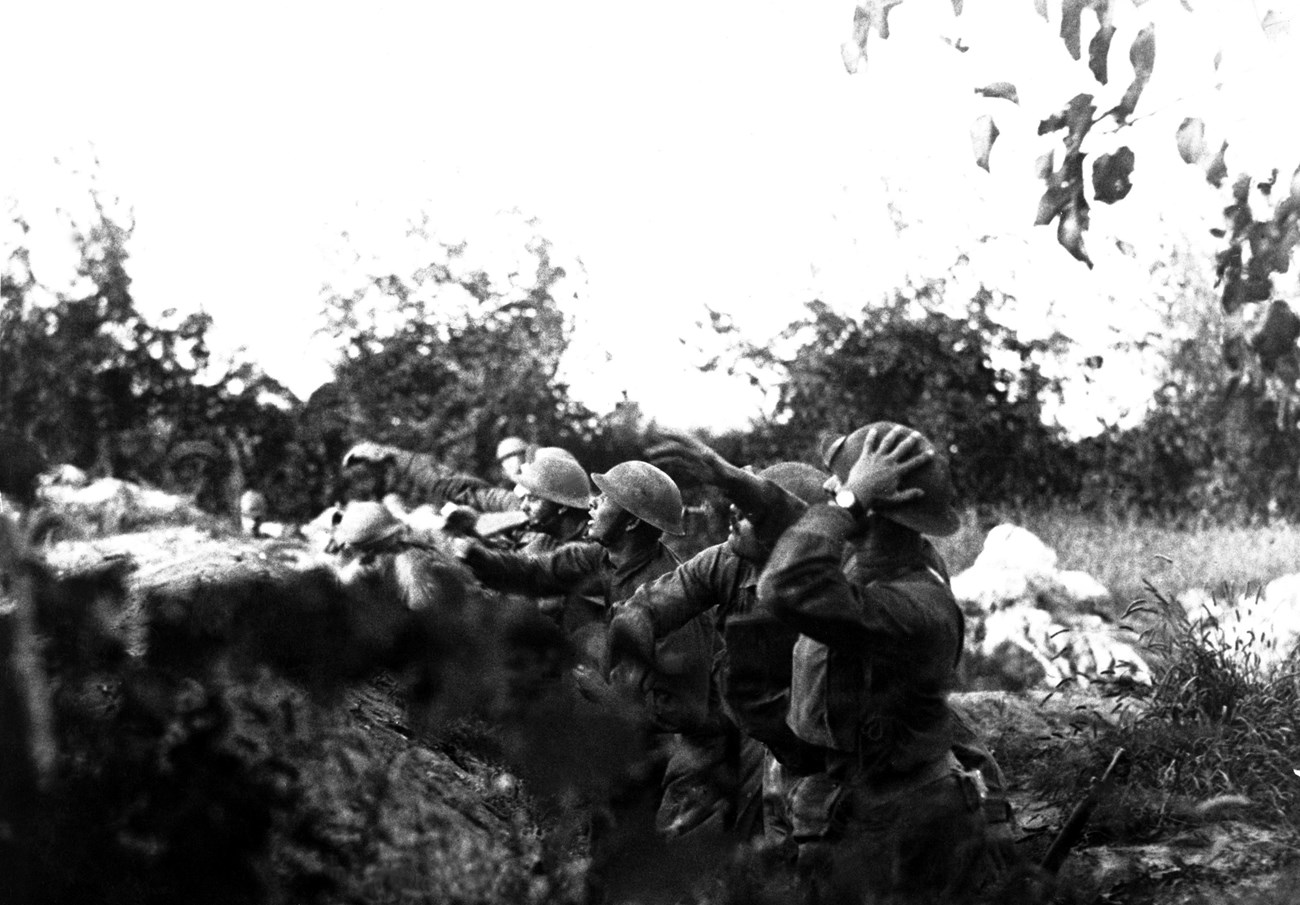
Germany planned to quickly defeat the British and French to the west before turning its full force east to Russia, but its initial thrusts into Belgium and northern France were checked. By the end of 1914, 400 miles of trench lines – the Western Front – stretched from Switzerland to the North Sea. Over the next three years, a series of bloody offensives failed to overcome the stalemate of trench warfare. In 1916 the Battle of the Somme lasted 140 days with more than a million casualties and moved the front lines six miles, while the German assault on Verdun yielded little gain at a cost of 700,000 dead and wounded. By 1917 both sides were nearing exhaustion. The United States initially remained neutral. But reports of German atrocities and submarine attacks on shipping bound for Britain and France – most infamously the 1915 sinking of the Lusitania, which killed 128 Americans – began to change American opinion. In 1916 President Woodrow Wilson won re-election on the slogan “He kept us out of war.” But in April 1917, Germany’s resumption of unrestricted submarine warfare, along with its offer to help Mexico recover territories lost to the United States in 1848, led Wilson to ask Congress to declare war on Germany. American entry came none too soon. The British were running out of men, almost half of the French army had mutinied, and the Russian Revolution in 1917 would lead to Russia’s withdrawal from the war, allowing Germany to shift troops to the Western Front. Although the first American soldiers landed in France in June 1917, it would take a year to create, train and equip an army and ship it across the Atlantic. The outcome of the war would turn on whether Germany could defeat Britain and France before the Americans arrived in force. The first elements of the American Expeditionary Forces, under the command of General John J. Pershing, arrived in France in June 1917, but they lacked the numbers and training to be committed to combat. There was also debate over how the AEF would be deployed. The Allies argued for the piecemeal assignment of American units to British and French armies; Pershing was adamant that the AEF would field an independent army under American command. The situation changed in early 1918 when Germany launched its “Spring Offensive,” intended to end the war before the Allies were reinforced by millions of Americans. At the peak of the crisis, Pershing relented and assigned American divisions to hard-pressed Allied armies. American troops conducted their first major action on May 28, 1918, when the 1st Division rolled back a German salient at Cantigny. Soon after, American forces were deployed along the Western Front, fighting in battles that have become part of American military lore. In early June, the 2nd Division, including a brigade of U.S. Marines, drove German forces out of Belleau Wood after weeks of savage fighting. At Chateau Thierry the 3rd Division won the name “Rock of the Marne” for its stand on the Marne River. More Americans joined Allied counterattacks in summer and fall 1918, fighting with British, Canadian and Australian allies in Flanders and the Somme, and with the French at Soissons and across the Marne, Aisne, and Oise rivers. By September 1918, the AEF began independent operations and played a key role in the “Hundred Days Offensive,” which ended the war. The Americans helped break the fortified Hindenburg Line at St. Quentin, and at St. Mihiel, half a million American and 100,000 French troops, supported by 1,500 Army Air Service aircraft, took back in four days territory the Germans had held for almost four years. On September 26 American forces launched the Meuse-Argonne Offensive, the largest battle in American history. Over 47 days, 1.2 million American troops drove the Germans back 40 miles to the vital railway hub of Sedan. More than 26,000 American soldiers died. As American troops moved through the Meuse-Argonne, it became apparent that Germany had lost the war. An armistice was signed on November 11, 1918, affective at 11 a.m. – the eleventh hour of the eleventh day of the eleventh month. In January 1919 the allies met in Paris to negotiate the peace. President Wilson sought a peace based on his “Fourteen Points,” meant to foster international peace and cooperation. While some of the terms were included in the final treaty, including creation of a League of Nations, the pre-war colonial system remained in place. The Allies also compelled Germany to accept responsibility for starting the war, giving up territory and colonies, and pay crippling war reparations. The formal Treaty of Versailles was signed on June 28, 1919, but the US Senate refused to ratify the treaty. The United States suffered 53,402 battle deaths in World War I, in less than six months of fighting. Another 63,114 died from accidents and disease. After the Civil War and World War II, World War I is the deadliest war in American history. |
Last updated: September 12, 2024
